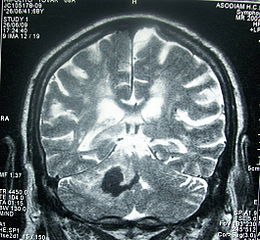For your good health. Always.
Menu
Enhance your health with free online physiotherapy exercise lessons and videos about various disease and health condition
Signs Of Neurological Disorders
by Helena Moreira
(Ontario)
MARCUS-GUNN PUPIL
Marcus-Gunn pupil, or relative afferent pupillary defect, is evident when one pupil paradoxically dilates to direct light when the flashlight swings between two eyes. Marcus-Gunn pupil is always unilateral and is seen in an optic nerve lesion anterior to the optic chiasm, such as retrobulbar optic neuritis or optic neuritis (papillitis), and rarely seen in compressive optic nerve lesions or retinal degeneration.
LHERMITTE’S SIGN
Lhermitte’s sign, or “barber’s chair sign,” is an electrical shock or paresthesia- like feeling running down the back when the neck is flexed or extended. This sign is usually seen in a cervical cord lesion such as demyelinating disease(multiple sclerosis), cervical spondylotic myelopathy, or cervical spinal cord tumor.
BRUDZINSKI’S AND KERNIG’S SIGNS
To test for these two signs, it is best to have the patient lie supine. Brudzinski’s sign is present when the knees and hips flex during passive neck flexion. Kernig’s sign is present when there is resistance to straightening the flexed knee. The positivity of these signs is indicative of meningeal irritation (meningitis, subarachnoid hemorrhage). These signs are not evident if the neck stiffness is not caused by meningeal irritation such as cervical spondylosis, Parkinsonism , or cervical lymphadenopathy. Unilateral Kernig’s sign may be seen in lumbar radiculopathy.
TINEL’S SIGN
This sign presents when a gentle percussion at the wrist produces paresthesias in the distribution of the sensory branches of the median nerve. This sign is often elicited in carpal tunnel syndrome, but also seen in other entrapment neuropathies (cubital tunnel syndrome).
FROMENT’S SIGN
This sign is present when pulling a piece of paper (or index card) between the thumb and index finger. The sign is positive when thumb flexion is seen. This occurs because the adductor pollicis muscle is weak and the long flexor is compensating. Froment’s sign can be detected in an early ulnar nerve lesion at the elbow, either unilaterally or bilaterally.
STRAIGHT LEG-RAISING TEST (LASEGUE)
With the patient in a supine position, lift the leg while holding the heel. Limitation of leg raise to 45–60°is suggestive of nerve root compression. Tightness of the hamstring muscles is not indicative of a radiculopathy.
PATRICK’S SIGN
This sign differentiates sacroiliac joint disease from lumbosacral radiculopathy. The sign is positive when placing the heel (symptomatic side) on the opposite knee and pressing the leg down and out causes pain in the hip region, indicating sacroiliac joint disease. The sign is negative in radiculopathy.
PRONATOR DRIFT SIGN
The patient’s hands are outstretched in front of the face with the palms facing upward and eyes closed. Drift of the arm with pronation of the hand is indicative of motor weakness because of an upper motor neuron lesion. This sign is checked with the weakness is subtle.
HOOVER’S SIGN
With the patient in the supine position, place your hand under the heel of one leg, and ask the patient to raise the other leg against resistance. Normally, you feel pressure on your hand. Hoover’s sign is positive when you do not feel pressure. This is a good sign to check when you suspect the weakness is because of hysteric conversion.
TODD’S PARALYSIS
Transient hemiparesis after focal motor seizure (postictal weakness). This sign is often mistaken for stroke or transient ischemic attack.
HALLPIKE’S TEST
Hallpike’s sign, or head-tilt test, is done for evaluation of positional vertigo. Hang the head of the patient gently from the bed, and while supporting the head, move the head to the right and then to the left, and note the presence or absence of nystagmus. Normally there is no nystagmus. In inner ear disease, the patient develops vertigo and nystagmus after a few seconds, which is fatigable. In a central lesion, nystagmus occurs immediately and does not fatigue.
PUPILLARY SPARING
Pupillary sparing is retention of pupillary reaction to light in cases of third cranial nerve palsy (ptosis and eye movement abnormalities). Pupillary sparing is seen in ischemic third nerve palsy such as in diabetics and hypertensive patients. It is less likely seen in compressive third nerve palsies such as aneurysm or tumors.
FISHER’S SIGN
Repeatedly tapping the middle joint of thumb with the tip of index finger causes other fingers to move synchronously. The absence of movement of other fingers is indicative of a corticospinal tract lesion.
FOREARM-ROLLING TEST
This test involves rapidly rolling one arm around the other. With a subtle pyramidal tract lesion, one arm does not roll around the other.
FOOT TAPPING SIGN
This sign checks the speed of foot tapping. Slowness of foot tapping may be as useful or even more useful a sign as Babinski sign for upper motor neuron dysfunction.
PARADOXICAL PTOSIS
In patients with unilateral ptosis, the contralateral lid may droop when you're closing or lifting the ptotic lid with your finger. This phenomenon(Herring Phenomenon) is often seen in ocular myasthenia gravis.
Return from Signs Of Neurological Disorders to Home Page
Return from Signs Of Neurological Disorders to Neuro Rehab
Return to Physiotherapy Discussion Board.


